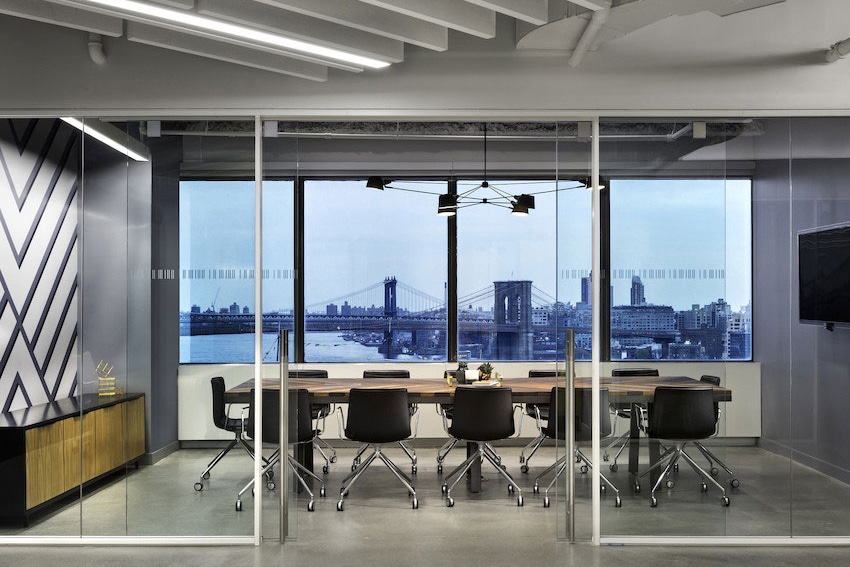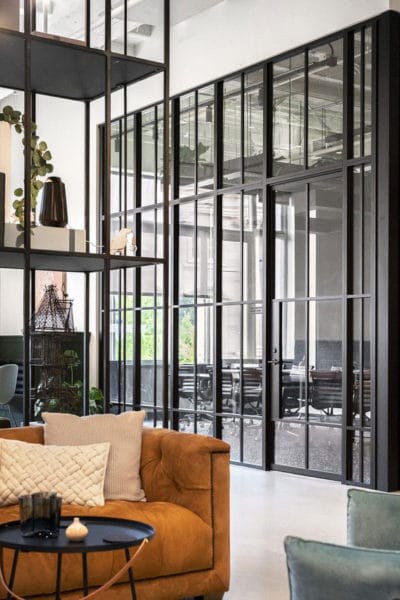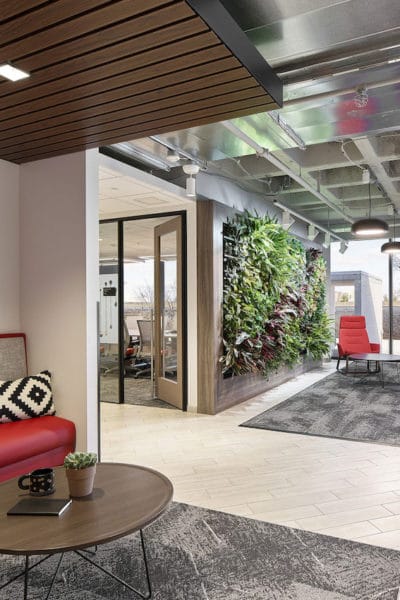Glass fronts are not new to office design, but their benefits are more clearly understood in the post-pandemic workplace—specifically as they relate to employee wellness and safety. And not only can they help keep workers safe, but glass office fronts can also contribute to lowering a building’s overall carbon footprint.
Let’s explore the many benefits of glass office fronts in three key areas: sustainability, safety, and employee wellness.
Sustainability
Every day we see the impact of climate change and understand the importance of creating and maintaining sustainable spaces and lowering our carbon footprints. Forward-thinking companies are always looking for ways to “rethink” office design and incorporate recyclable and reusable materials.
By the essence of the components involved, glass office fronts are a beautiful option that is both recyclable and reusable. Demountable by nature, many office fronts can be installed, taken down, reconfigured, and installed again, allowing companies to breathe new life to their office layout while saving money and reducing waste.

Using glass office fronts with other natural elements, such as in this office space in New Jersey, can help contribute to LEED status. Combining sustainable materials along with green practices help to reduce the overall impact on our environment. Photo courtesy of Transwall
Additionally, glass and aluminum—the materials required for glass office fronts—are some of the best and easiest materials to recycle. Glass is 100% recyclable and can be recycled endlessly without loss of quality or purity. Aluminum is one of the most efficient and widely recycled materials. Recycling aluminum saves 95% of the energy cost of processing new aluminum.
Aside from traditional glass fronts, partnering with other demountable systems for demising walls can increase the flexibility of the built space while also providing a sustainable alternative to drywall.
According to the Environmental Protection Agency, roughly a decade ago, the US generated a little over 103 million tons of construction and demolition waste in commercial development. Through incorporating demountable fronts and demising walls, less waste is landfill bound. Here are a few other key environmental benefits of a demountable partition system:
- They are reusable and reconfigurable. If you do decide to demolish, demountable partition systems are made of highly recyclable materials.
- Demountable partition systems often credit toward LEED status.
- You can save on shipping due to being lighter weight, which lowers carbon emissions from transporting vehicles.
Demountable partitions also offer many options when it comes to finishes, data and electrical access, as well as sound transmission levels.
Safety
As the COVID-19 pandemic makes all of us rethink how and where we work, employee safety has become the most important aspect of getting us back into the office. Ultimately none of us know for sure how the nature of the workplace will change because of the pandemic, but we do know that it will change. Some solid predictions include an increased need for sanitization and low-touch design, space for social distancing, and of course protective equipment to decrease the spread.
It is amazing when you stop and think of all the surfaces we come into contact with throughout the day. The number of door handles, countertops, drawer pulls, keypads, and elevator buttons that we touch is astounding. And with the increased need for sanitization of these areas, there is a greater importance placed on the anti-microbial design and materials with properties able to hold up to strong detergents and chemicals.
- Incorporating an antimicrobial coating to the powder coat finish adds a layer of protection against viruses and bacteria. On treated surfaces the bacterial proliferation is practically zeroed. Partnered with regular sanitizing, this can significantly decrease the spread of illnesses throughout an office space. Photo courtesy of Transwall
- Studies have shown that natural light reduces instances of eye strain, headaches, and drowsiness while also boosting mood, productivity, and work performance. Coupled with biophilic design elements such as this living wall, glass office fronts help to feed our innate desire to connect with nature. Photo courtesy of Transwall
Anti-Microbial Materials and Finishes
- Copper and its alloys (brasses, bronzes, cupronickel, copper-nickel-zinc, and others) are natural antimicrobial materials.
- Copper is the first solid surface material to receive EPA registration.
- Anti-microbial coating (AMC) is an innovative finish that contains special additives to protect surfaces from bacteria and microorganisms.
- Incorporating either copper or anti-microbial coated hardware in office spaces can help lower the risk of spreading illness through contact with high-touch surfaces. When cleaned regularly, copper kills greater than 99.9% of common bacteria within two hours of exposure.
With hardware treated with an anti-microbial finish, the bacterial proliferation is practically zeroed. Anti-microbial coating can also be added to powder coat paint and applied to door frames, ceiling and floor tracks, as well as painted wall panels.
In addition to treated hardware, other hardware improvements include automatic or low-touch additions. For example, adding a separate forearm shield for either ladder pulls or lever sets is a great retrofit, low-cost solution, especially if you need something quickly. An automatic sliding or pivot door with closer may be a better choice when it comes to new design or full office renovation.
Glass Partitions
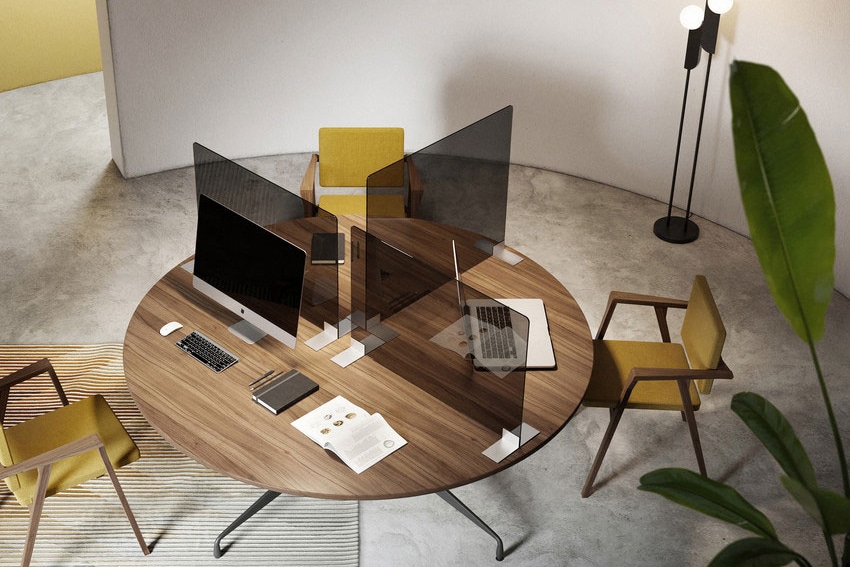
Adding a desktop divider creates an additional layer of safety and a sense of privacy for employees with shared worktables. Dividers are a lightweight solution that can be adjusted when workspace configurations change. Because they are made of glass, they are able to stand up better to multiple cleanings with harsher chemicals than dividers made of acrylic or plexiglass. Photo courtesy of Transwall
Incorporating glass panels and desk dividers to open office settings can also help increase employee safety. With the majority of offices have some element of open plan space and shared workstations comes increased exposure to airborne droplets that may carry viruses or bacteria. Glass partitions, partnered with better HVAC and air quality systems, can help to make the workplace safer and offer peace of mind to employees.
Compared with its plexiglass and acrylic counterparts, glass partitions and dividers come with additional benefits, including:
- Glass tends to be less expensive.
- It’s easier to clean and stands up to harsher chemicals.
- Glass is more resistant to scratches and therefore maintains transparency after repeated cleanings.
- It’s more easily recycled and thus has a lower environmental impact.
Beyond flexible dividers, private offices add another layer of protection to employees. Although the cost impact initially is more expensive, the returns on increased productivity, higher employee engagement, and lower turnover exponentially increase the return on investment. Here are a few other benefits:
- Due to contained spread of illnesses, private offices mean fewer missed workdays.
- Private offices allow for fewer distractions, especially aural.
- There’s a greater sense of privacy and comfort, particularly when having phone conversations or meeting with clients regarding sensitive matters.
- Private offices can lead to lower instances of social drama due to proximity annoyances because of less shared space.
Both employee wellness and safety increases with instances of private office space. As with anything, it is a balance between finding spaces for collaboration and areas to cut costs, along with finding opportunities to boost morale, reduce turnover, and increase productivity. Smaller conference rooms, huddle spaces, telephone, and breakout rooms are a great way to expand opportunities for private and semi-private space without having to make an individual office for everyone.
Employee Wellness
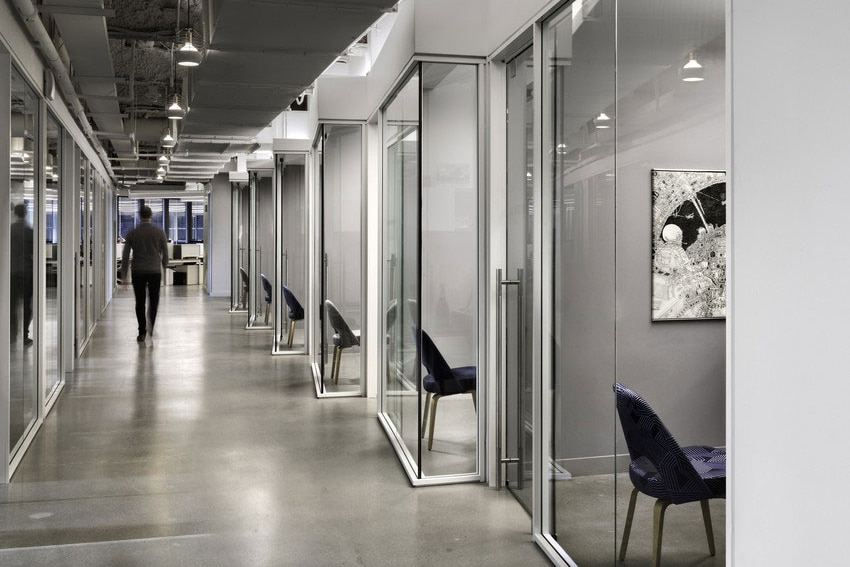
Incorporating more private office space into design grants increased opportunities for employees to feel connected to their office environment and establish and sense of ownership and privacy. Employees often feel more comfortable having conversations with clients and can focus better without the outside distractions from coworkers. Photo courtesy of Transwall
As many of us have seen, the modern office is an ever-evolving concept. Design trends come and go, but at its basis, the elements of office design tend to remain the same. One of these key elements are access to daylight.
Recently more importance has been placed on access to natural light and its effects on employee wellness and productivity. When stacked up to amenities such as cafeterias and fitness centers, views of the outdoors and natural light were ranked the No. 1 office perk.
Workplace Benefits of Natural Light
- Natural light reduces instances of eyestrain, headaches, and drowsiness.
- Natural lights improve moods, work performance, and productivity through healthier and happier employees.
- Employees with access to natural light and outdoor views on average take 6.5% fewer sick days.
- Natural light can help lower utility costs through reducing the use of, and need for, artificial lighting.
By incorporating a minimal profile glass front, you can maximize connectivity to daylight and outdoor views while still creating an acoustically balanced environment for focus and work. Historically executive offices had the monopoly on windows and views. With glass office fronts around the perimeter and at the center of the space, all employees will have better access to natural light and views of the outside.
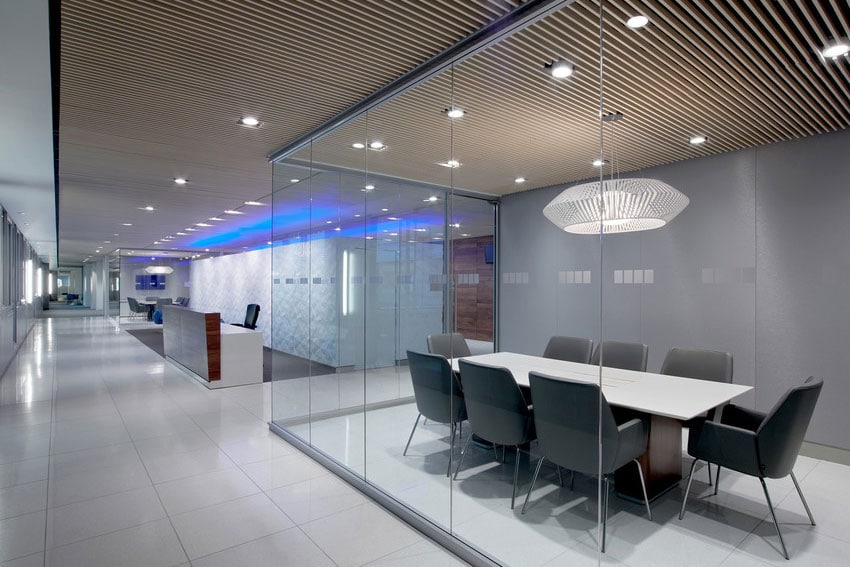
Demountable partitions made of aluminum and glass, like ONE by Transwall, are a sustainable alternative to traditional drywall. Comprised of recyclable materials, they can help to keep unnecessary waste out of landfills. Demountable systems can also be reconfigured and reinstalled, reducing the amount of materials used and lowering your overall carbon footprint. Photo courtesy of Transwall
The Importance of Acoustical Balance
In addition to daylight and views of the environment, glass walls can create an acoustically balanced workspace while still providing transparency and that ever important human connection. Here are a few reasons why acoustics play a key role in office design:
- Noise pollution is a large contributing factor to poor productivity
- A recent study by Udemy showed that 80% of respondents cite coworker chatter as their biggest distraction.
- Too quiet of spaces can also be distracting, as other sounds we would not normally notice become enhanced.
- Poor acoustics lead to more noise, which causes employee stress.
Having places for focused and heads down work as well as collaborative spaces for brainstorming and connecting are equally important. With acoustics being a key factor in employee wellness and productivity, implementing a high STC double glaze office front, particularly for conference spaces and huddle rooms, allows for increased sound mitigation while keeping the space open and vibrant.
It is also important to keep in mind that all elements of the space contribute to sound transmission. Adding soft materials, such as carpeting, fabric wrapped demising walls, and upholstered furniture, can help to absorb sound and lower the overall sound transmission.
Ultimately the goal with any office space is to create an environment that inspires, encourages, and embodies the company, its culture, and its employees. Dynamic offices using glass fronts strike a unique balance between design aesthetic, employee safety and wellness, and sustainability. Each of these factors plays a huge role in recruiting, engaging, and retaining the best talent, while doing what is best for our climate and our future.

